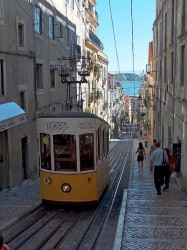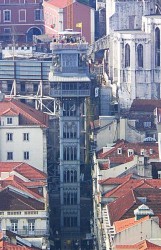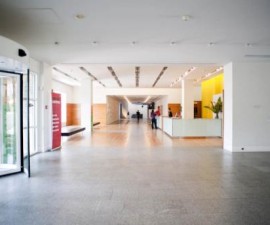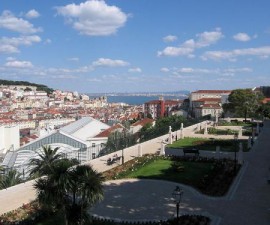
With much of Lisbon climbing steeply away from the Baixa (downtown area) and the banks of the Tagus River, there are some superb viewpoints from which to marvel at Portugal’s picturesque capital city. Reaching them can be a little hard on the legs however, so it is fortunate that Lisbon has an effective bus, metro and tram system.
This interconnecting system is further enhanced by three street funiculars and one street elevator, which provide quick and easy access to some of the hillier districts. These are known collectively as the Lisbon funiculars.
The Lavra funicular was not just the first of its kind in Portugal: it was the world’s very first street funicular. It was opened in 1884 and was originally powered by water, though it was converted subsequently to electricity in 1915. It climbs from the eastern side of the Avenida da Liberdade, on the Largo da Anunciada, up a 25% gradient to the Torel district.
Following the success of the Lavra funicular, a further funicular was opened the following year, in 1885. The Gloria Funicular departs from the western side of the Avenida da Liberdade and connects the Restauradores area via an 18% gradient with the Bairro Alto, home of Lisbon’s vibrant nightlife.

The Gloria funicular is 265 metres long and operates daily, as does the Lavra funicular.
There is a tourist information office close to the departure points for both the Gloria funicular and the Lavra funicular, making them convenient stops during your sightseeing tour of central Lisbon.
The third of its kind to serve Portugal’s capital city is the Bica funicular. The Bica Funicular is 245 metres long and is the only stepped street funicular in the city. It climbs the Rua da Bica from the Rua Sao Paulo, near Santos, to the Calhariz district up an average gradient of 20%.
Look out for the “Ascensor da Bica” signage when you go in search of the Bica funicular as it is concealed from view from the street.

The Bica funicular is served at the top end by tram 28 and at the bottom end by tram 25, two of the most important routes that serve the bulk of Lisbon’s must-see attractions. The streets around the Bica funicular are amongst the most popular for Lisbon nightlife, on the fringes of the vibrant Bairro Alto district.
The Bica is also located just a five minute walk from the Adamastor, one of Lisbon’s most popular gathering places and viewpoints, officially known as the Miradouro de Santa Catarina.
Complementing the Lisbon funiculars is the Santa Justa Elevator. The Santa Justa Elevator rises some 45 metres from the Rua de Santa Justa in the Baixa, up to the popular and sophisticated Chiado district. The elevator comprises two staffed lifts which usually provide direct access to the Carmo square and its monastery ruins, which now form an archaeological museum.
At the top, the Santa Justa Elevator opens out to a viewing deck which looks over the Rossio district to the northeast and the Baixa district below to the south. It is also possible to see the Castle and Graca from here.


